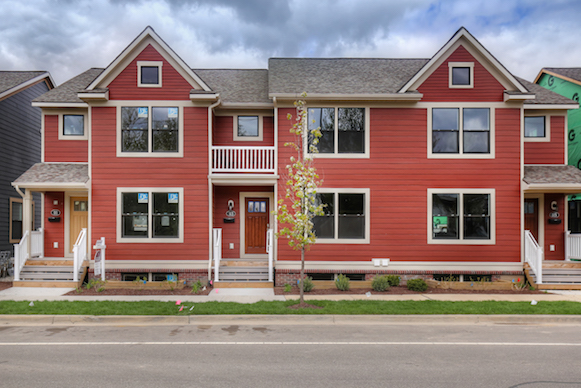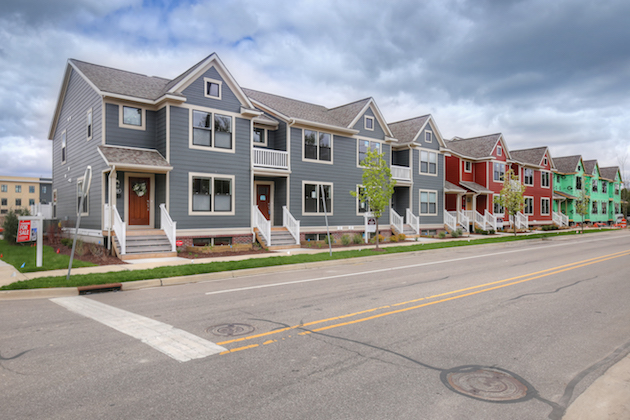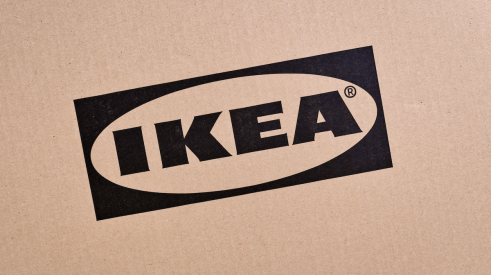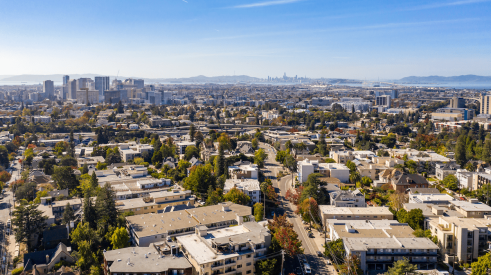Tapestry Square, a four-block redevelopment project on the rapidly growing southeast side of Grand Rapids, Mich., is giving low- and moderate-income families a shot at homeownership. For the last 10 years, the nonprofit Inner City Christian Federation (ICCF) has been infusing the site with a mix of new housing, retail, and business opportunities.
Once a healthy, economically diverse neighborhood with a mix of uses, the Tapesty Square neighborhood became an undesirable place to live in the 1970s, says Ryan VerWys, ICCF’s president and CEO. “The violence in Detroit spilled over to Grand Rapids,” says VerWys. “There was a pattern of segregation and disinvestment, with many vacant lots and buildings.”
Affordability is a serious problem in Grand Rapids, as it is in many cities. When the foreclosure crisis hit the city in 2011, investors snapped up scores of single-family homes. Home prices have skyrocketed 60 percent during the last five years, which is why VerWys believes that “Everyone deserves beautiful housing regardless of income.”
In 1974, ICCF began renovating and selling old single-family detached houses to low-income buyers, and has done more than 500 to date, according to VerWys. By the 1990s, perceiving a need for rental housing, the organization canvassed neighbors who said it would have to be walkable and safe, with green space for common areas and options for mixed-income households.
So between 1992 and 2010, ICCF assembled properties for affordable rental housing. “The city was very cooperative, and we had lots of partners,” says VerWys. Construction at Tapestry Square started in 2012 with two multifamily buildings containing street-level retail and a total of 32 units; a percentage were designated for households earning between 60 and 120 percent of the area median income. In 2016, ICCF built 18 for-sale townhomes on the site, of which nine were purchased by low-income buyers.
Tapestry Square projects a pedestrian-friendly “face” with its combination of front porches, zero-lot-line multifamily buildings, and interconnected sidewalks, says VerWys.
The numerous financing sources included federal Low-Income Housing Tax Credits; HOME Investment Partnership funding through the city of Grand Rapids and the Michigan State Housing Development Authority; a loan from the Federal Home Loan Bank of Indianapolis; and donations from local foundations. ICCF is seeking LEED Silver certification for the project.
Townhome exteriors are clad in brick, stone, and fiber-cement siding, with large windows and high-quality interior finishes. The architecture has a timeless aesthetic that feels traditional in scale, massing, and finish “without faking being historic,” VerWys says.
In this Tapestry Square townhome, an open-concept first floor maximizes living space. A side room or den offers additional square footage. Photo: Harr Photography for the Steve Volkers Group
“The design elements reflect the earlier apartment buildings, but have their own identity [to make the transition] to two-story townhomes over retail,” says DeStigter. “They’re set back a bit from the street, with covered porticoes that create a welcoming ambience.” Other touches such as double-hung windows and cornice roof details distinguish the building from the rest of the project.

The townhomes reinforce the pedestrian-friendly nature of the neighborhood with front porches, rear-loaded garages, and small, private back yards. Photo: Harr Photography for the Steve Volkers Group
Grand Rapids’ strong economy is drawing new residents, DeStigter says: “It has a vibrant urban core, affordable housing, and a booming job market.” According to The Right Place, an economic development organization in West Michigan, the Grand Rapids region is the fastest growing in the state. And right now, urbanization is a big trend, notes VerWys: “It’s cool to live in the city again.”
At press time, all 82 residential units, for-sale and rental, were either sold or leased.
Plans for future development of the Tapestry Square site are underway. ICCF has applied to change the zoning of one parcel, which is in front of a rapid-transit bus stop, to a Traditional Neighborhood Development/Transit-Oriented Development. The organization hopes to build a 104-unit, senior-living development of up to 7 stories. Sixty percent of the units will be set aside as affordable, and there will be ground-floor space with a restaurant and other retail uses. No funding had been secured at press time (ICCF will submit an application for LIHTCs this fall), but there is already a 750-person waitlist.
Advertisement
Related Stories
Innovation
IKEA Model Home Aims to Ease the Trauma of Homelessness
Blending innovation with empathy and eco-conscious design, IKEA US unveils a pioneering model home in its Live Oak, Texas, store
Affordability
How Much Income Do First-Time Buyers Need to Afford the Average Home?
The median-priced home is unaffordable in 44 of the 50 largest U.S. metro areas
Affordability
What Is the Relationship Between Urban vs. Suburban Development and Affordability?
A new paper from Harvard's Joint Center looks at whether expanding the supply of suburban housing could, in turn, help make dense urban areas more affordable







